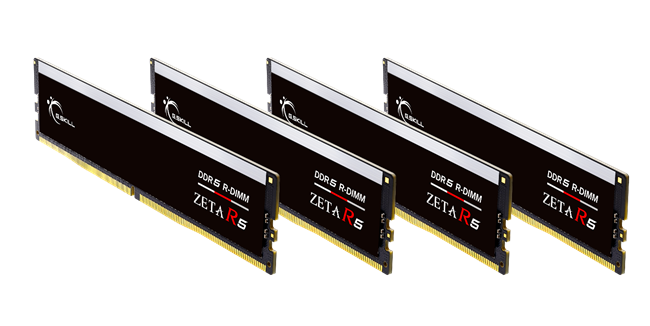G.Skill Zeta R5 DDR5 RDIMMs: Up to DDR5-6800 for Intel Xeon W-3400X and W-2400X
G.Skill has announced its first RDIMM memory products to the market, their Zeta R5 memory series. Designed for use with Intel's new Sapphire Rapids workstation processors, the Zeta R5 DDR5 RDIMMs are explicitly intended for use with Intel's Xeon W-3400X and W-2400X series processors, with integrated XMP 3.0 profiles and proper out-of-band ECC support (not just on-die ECC memory as with DDR5 UDIMMs). It also marks G.Skill's first time venturing into the workstation memory market, with kits ranging from DDR5-5600 to DDR5-6400.
Typically G.Skill focuses on manufacturing high-end memory for desktop platforms. G.Skill's memory ranges, such as the Trident Z5, are a favorite among enthusiasts and overclockers around the globe. While its Trident Z5 modules have been pushed up to DDR5-8888 using Intel's 12th Gen Core series platform, we've seen G.Skill DDR5 memory hitting extreme heights of DDR5-10350 courtesy of extreme overclocker Safedisk.
While not as flexible with memory configurations and the overclockable nature of G.Skills UDIMM memory, Intel and its latest Xeon W-3400 and W-2400 processors for workstations based on its Sapphire Rapids architecture look to break the mold by being one of the first workstation platforms to introduce fast and overclocked XMP memory profiles. Combining the steadfast nature of ECC RDIMM memory with overclocking is a stark contrast to what is considered the norm for the highly conservative and stability-focused workstation market.

G.Skill Zeta R5 DDR5 RDIMM module
G.Skill has not only developed its latest Zeta R5 RDIMM DDR5 memory for Intel's Sapphire Rapids workstations, but its fastest kit comes with an XMP profile of DDR5-6400 with CL32 latencies in capacities of up to 128 GB (8 x 16 GB) and 64 GB (4 x 16 GB). Other kits announced from G.Skill's latest Zeta R5 DDR5 RDIMM memory include three varieties of DDR5-6000 memory, each with different CAS latencies and capacities. The G.Skill Zeta R5 DDR5-6000 memory comes with tighter latencies of CL 28-39-39-96 while also being available in 128 GB (4 x 32 GB and 8 x 16 GB) and 64 GB (4 x 16 GB).
| G.SKill Zeta R5 Series DDR5 RDIMM Memory Specifications | ||
| Frequency | Latency Timings | Capacities |
| DDR5-6400 | 32-39-39-102 | 128 GB (8 x 16 GB) 64 GB (4 x 16 GB) |
| DDR5-6000 | 28-39-39-96 | 128 GB (4 x 32 GB) 128 GB (8 x 16 GB) 64 GB (4 x 16 GB) |
| DDR5-6000 | 30-39-39-96 | 256 GB (8 x 32 GB) 128 GB (4 x 32 GB) 128 GB (8 x 16 GB) 64 GB (4 x 16 GB) |
| DDR5-6000 | 32-38-38-96 | 256 GB (8 x 32 GB) 128 GB (4 x 32 GB) 128 GB (8 x 16 GB) 64 GB (4 x 16 GB) |
| DDR5-5600 | 28-34-34-89 | 256 GB (8 x 32 GB) 128 GB (4 x 32 GB) 128 GB (8 x 16 GB) 64 GB (4 x 16 GB) |
Looking down the G.Skill Zeta R5 DDR5 RDIMM product stack, there are two more kits with 6000 MT/s, this time with latencies of CL 30-39-39-96 and CL 32-38-38-96. These kits are available in kits of up to 256 GB (8 x 32 GB), 128 GB (8 x 16 GB + 4 x 32 GB), as well as a 64 GB (4 x 16 GB) kit. The slowest kit of G.Skill Zeta R5 features speeds of DDR5-5600 with tighter latencies of CL 28-34-34-89 and also comes available in 256 GB, 128 GB, and 64 GB kits; the same capacities and configuration as the two DDR5-6000 kits mentioned above.
Intel's Xeon W-3400 and W-2400 series support eight and four channels of memory, respectively. Memory support is also dependent on Intel's W790 workstation motherboards. It should be noted that because Intel's Xeon W-3400 and W-2400 processors require RDIMMs (a first for the Xeon workstation family), these new RDIMM kits with integrated XMP profiles are only designed for the aforementioned Xeons. And even then, only the X series chips, such as Intel's latest 56-core overclockable goliath, the Xeon w9-3495X, feature official support for memory overclocking.
G.Skill hasn't shared any details on the expected pricing of its Zeta R5 series of RDIMM DDR5 memory. G.Skill does, however, state that their Zeta R5 series will be available sometime in March.
Source: G.Skill
from AnandTech https://ift.tt/iNg8QBb








Post a Comment